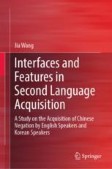Search
Search Results
-
Semantic variation in exclusive quantifiers
This article develops a comparative semantic analysis of representative focus-alternative quantifiers in English and Japanese: (i) only in English,...

-
Different Antecedent–Relative Clause Relations
In this chapter we spell out the semantic implications of the point that the antecedent of restrictive relative clauses is the nominal head plus...
-
Introduction
Reference works on English tend to recognize only clefts introduced by it + be, which are viewed as focus marking constructions, with an assumption...
-
Natural Grammar
The theory of natural grammar views grammars as language specific semiotic systems that naturally symbolize semantics by structural assembly. The...
-
Bikol clefts and topics and the Austronesian extraction restriction
Many Austronesian languages exhibit an extraction restriction whereby only one particular DP—the “pivot” argument, the choice of which is reflected...

-
Are predictors of reading impairment in isolated cleft similar to those in idiopathic dyslexia?
Children with isolated cleft of the lip and/or palate (iCL/P) are at increased risk for reading impairment. The purpose of this study was to evaluate...

-
Structural Assemblies and Semantics of the Four Existential Constructions with Relative Clause
This chapter analyses the structural assemblies and semantics of the four existential constructions with relative clause. A simple existential clause...
-
Conclusion
The mainstream equates clefts in English with it-clefts and holds that their grammar non-compositionally codes focus marking. In the previous...
-
Prosodic Patterns in the Four Existential Constructions with Relative Clause
This chapter looks for prosodic distinctive properties and tendencies of the four constructions. Existentials with non-restrictive relative clause...
-
Paradigms of Relative Markers
This chapter is concerned with the paradigms of relative markers found in English in restrictive and non-restrictive relative clauses and relative...
-
Determiners of Existent NPs in the Four Existential Constructions with Relative Clause
This chapter examines how the meaning of the four existential constructions with relative clause impacts on the determiner structure of their...
-
Compilation and Prosodic Analysis of Data
In this chapter we set out the functional phonological principles that have informed our transcription of the data compiled from the first London...
-
Les phrases pseudo-clivées inversées dans la traduction scientifique dans l’Italie de la fin du 18e siècle
Au 18e siècle, la traduction de textes scientifiques joue un rôle fondamental dans la création de périodiques scientifiques qui s’adressent...
-
Existential there versus Demonstrative there
To develop a natural grammar account of existential constructions, it is crucial to describe the formal properties and semantics of existential there...
-
(Embedded) short answers to wh-questions in Mandarin Chinese
The purpose of this paper is twofold. First, it investigates the formation of Mandarin embedded short-answer sentences. Given the fact that this type...

-
Focus without pitch boost: focus sensitivity in Japanese why-questions and its theoretical implications
Unlike typical wh-questions, why -questions are known to be focus-sensitive, but the linguistic realization of their focus sensitivity shows an...

-
Critical Stylistic Analysis of Bloody Crown by Sherko Bekas
This chapter continues with the presentation of an analysis of our translation of the second poem entitled Bloody Crown, a poem Bekas wrote to...
-
Antecedent-contained argument ellipsis in Japanese
This article aims to provide new and solid evidence for the observation made in the previous literature that antecedent containment needs to be...
-
Theoretical Frameworks and Related Studies
The Interface Hypothesis advanced by Sorace and Filiaci (2006) assumes that language structures involving an interface between syntax and other...
-
Adjectival sluices in Hungarian
Hungarian adjectival sluices show agreement characteristics of predicative adjectives, even though the correlate of the adjective is in attributive...

